Ampere Law and Magnetic Fields Class Assignment
Note
This is my undergraduate assignment that I translated to English (Bahasa Indonesia dibawah / Indonesian below) in the Electric Field Theory course where my task is to write an essay on the Amperes Law and Magnetic Fields. Apart from me this group consists of Vencisisca Jeane R, Rr. Sanita Eling Cipta Nesa, Putu Arie Pratama, Fajar Purnama, Muhammad Audy Bazly, Muhammad Nordiansyah. This assignment has never been published anywhere and we as the authors and the copyright holders license this task customized CC-BY-SA where anyone can share, copy, republish and sell on condition to state our name as the author and inform that the original and open version available here.
Chapter 1 Introduction
1.1 Background
In everyday life, many applications of several physical laws occur, one of which is Ampere's law and magnetic fields. Where in general the relationship between Ampere's law and magnetic fields, namely the Ampere's law states that the magnetic field can be generated in two ways, namely through an electric current (the initial formulation of the Ampere law), and by changing the electric field (Maxwell's addition). Maxwell's correction of the Ampere law is quite important, thus this law states that changes in the electric field can give rise to a magnetic field, and vice versa.
Three genius scientists from France, Andre Marie Ampere (1775-1863), Jean Baptista Biot (1774-1862) and Victor Savart (1803-1862) stated that the force will be generated by an electric current flowing in a conductor that is between the magnetic fields. This is also the reverse of Faraday's law, in which Faraday predicts that an induced voltage will arise in a moving conductor and cut across the magnetic field. This law is applied to electric machines, and the image below will explain this phenomenon.

Figure 1.1 Right Hand Rule
1.2 Problem
The problems raised in this assignment are as follows:
- What is the meaning of the Ampere's law and magnetic field?
- How is the relationship between current density and magnetic field?
- What is magnetic flux density?
- What is meant by magnetic vector potential and how is it applied?
- What is the stokes theorem?
1.3 Objective
The main purpose of writing the assignment "Ampere Law and Magnetic Field" this time is to know and understand in detail about Ampere's law and magnetic fields. The other objectives of this paper are:
- Able to define and explain Ampere's law and magnetic field.
- Find out how the relationship between current density and magnetic field.
- Able to define and know magnetic flux density.
- Able to explain the meaning of potential vectors and be able to explain how it is applied.
- Be able to define the stikes theorem.
1.4 Benefit
The benefits obtained from the paper "Ampere Law and Magnetic Field" are as follows:
- Provides in-depth knowledge of Ampere law and magnetic fields.
- Provides knowledge of the relationship between current or current density and magnetic fields.
- Gives knowledge about the vector potential that can be determined from the flow.
1.5 Scope of Material
In this assignment, the scope discussed by the author is limited to the issues discussed, namely the Ampere Law and Magnetic Fields.
Chapter 2 Discussion
2.1 Biot-Savart Law
The magnetic field differential, dH is the result of the current element differential I dH. The field is inversely proportional to the distance (r2), is a free medium that is around it and has a direction which is the cross product of I dI and aR. This relationship is known as the Biot-Savart Law, where the equation can be, seen as below:
dH = (I dI x aR)/(4πR2) (A/m)
The direction of R must come from the current element at the point where dH has been determined, as in the following figure:
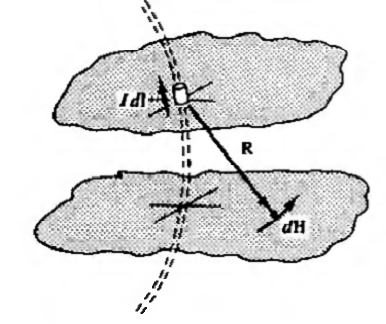
Figure 2.1 R and dH directions
Current elements must not be separated. All elements complement the current filament contribution to H and the current must be involved. The integral form in Biot-Savart's Law is as follows:
H = ∮(I dI x aR)/(4πR2)
A simple closed integral requires all the current elements involved in obtaining the H.
Example Problem 1:
Current I is long and straight along the z-axis of the cylindrical coordinates as shown in the figure below.
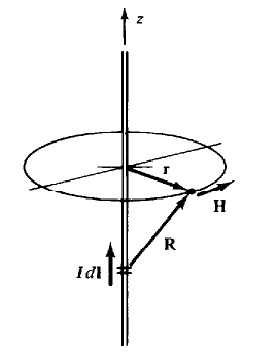
Figure 2.2 Example Problem 1
Without losing any of its general properties, choose a point in the z = 0 plane. Then in its differential form, it is as follows:
dH = (I dz ax X (rar X zaz) / (4π(r2+z2)<sup>(3⁄2))
= (I dz ra∅) / (4π(r2+z2)(3⁄2))
H = [∫-∞∞(Ir dz) / (4π(r2+z2)(3⁄2))] a∅
= a∅/2πr
The magnetic field by surface currents and volume is also given by the Biot-Savart law of integral form, where I dI is replaced by K dS or Jdv respectively, and where the integral is taken over the entire surface, or volume, concerned. An important example is the current in an infinite plane with a constant density K. Where the equation can be seen as follows:
H = K/2 X an
2.2 Ampere Law
The line integral of the tangential component H along the closed path is equal to the magnitude of the current in the vicinity:
∮H.dI = Ienc
This is Ampere's law. At first sight, we might think that the application of this law is to determine flow by an integration. In fact, usually the current is known and this law will give us a way of determining H. So the application of the law is very similar to using Gauss's law to determine D in a given charge distribution.
To be able to take advantage of Ampere's law in determining H there must be a sufficiently high degree of symmetry to the problem being discussed. The two conditions that must be met are as follows:
- H must be normal or tangential at each point of its path.
- H has the same or constant value for each point of its path, if H is tangential.
The Biot-Savart law can be used to determine which path meets these conditions. But in most cases, the path is immediately visible.
Example Problem 2:
Use the amperes law to get H by a long, straight current I. The Biot-Savart law shows that H is tangential and with the same magnitude along the circle in Figure 2.3, then the equation is as follows:
∮H.dI=H(2πr)=I
H = aϕ/2πr
2.3 Curl
The curl of the vector field A is another vector field. Point P in Figure 2.3 is located in the area ∆S which is bounded by closed curve C.
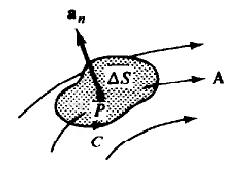
Figure 2.3 Curl at Point A
In the integration that defines curl, C is the area traversed by the curl so that the closed area is on the left. Normal units, determined using the rule of thumb, are as shown in the figure. Thus, the curl component of A in the direction an is defined as follows:
(curl A).an = lim(∆S→0)(∮A.dI/∆S)
In the coordinate system, curl A is the fully specified value defined by the component along the three vector units. For example, the x component of Cartesian coordinates is defined by taking the contour line C of the square in the plane x = conts, via the point P, as shown in Figure 2.5:
(curl A).an = lim(∆y ∆z→0) (∮A.dI / ∆y ∆z)
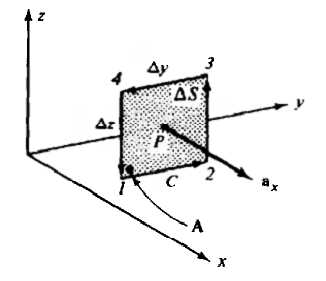
Figure 2.4 Curl on a Square
If, A = Axax + Ayay + Azaz, at the angle from closed ∆S to the center (point 1), then:
∮ = ∫12 + ∫23 + ∫34 + ∫41
=Ay∆y + (Az+(∂Az/∂y∆y))∆z + (Ay+(∂Ay/∂z∆z))(-∆y) + Az(-∆z)
=((∂Az/∂y)-(∂Ay/∂z)) ∆y∆z
(curl A).ax = (∂Az/∂y)-(∂Az/∂z)
The y and z components can be determined in the same way. The combination of the three components can be seen in the equation below:
curl A = ((∂Az/∂y)-(∂Az/∂z)) ax+((∂Ax)/∂z-(∂Az)/∂x) ay+((∂Ay)/∂x-(∂Ax)/∂x) az (cartesian)
The third-order determinant can be written like the equation below, the expansion of which gives the Cartesian curl of A.
curl A=|(ax&ay&az @ ∂/∂x&∂/∂y&∂/∂z @ Ax&Ay&Az)|
The elements of the second line are components of the del operation. This shows that ∇ × A can be written for curl A. As with other expressions of a vector analysis, this notation is used for curl A in other coordinate systems, even though × A is defined in Cartesian coordinates only.
The expressions for curl A at the coordinates of the cylinder and the sphere can be derived in the same way as above. Although, with a higher difficulty.
curl A = (1/r (∂Az)/(∂∅) - (∂A∅/∂z)) ar + ((∂Ar/∂z) - (∂Az/∂r)) a∅ + ((∂(rA∅))/∂r - (∂Ar/∂∅)) az (cylinder)
curl A = 1/(r sin ) [(∂(A∅ sinθ))/∂θ - (∂θ/∂∅)] ar+1/r [1/sinθ (∂Ar/∂∅)-(∂(rA∅)/∂r)] a∅ + 1/r [(∂(rA∅))/∂r-(∂Ar)/(∂∅)] az (spherical)
The frequency of use of the two properties of the curl operator can be explained as follows:
- The difference from curl is scalar zero, that is: ∇. (∇ × A) = 0 for each vector field A
- The curl of the gradient is zero vector, that is: ∇. (∇f) = 0 for any scalar function of position f (see problem) Under static conditions, E = -∇V, so ∇ × E = 0
2.4 The relationship of J and H
In the law of amperes, the equation definition of (curl H) x can be written as follows:
(curl H).ax=lim(∆y ∆z→0)Ix/(∆y ∆z)- Jx
Where Jx = dlx⁄dS is the area of density in x direction of current. So that the x component of curl H and direction of current J are the same at every point. Likewise for the x and y components, it can be seen as follows.
∇×H=J
This is one of Maxwell's equations in the static electric field. if H is known for the entire region, then ∇ × H = J will produce J for the region.
Sample Problem 3:
A conductor whose cross-section length is straight with radius a has a magnetic field strength H = (Ir⁄2πa2) in the conductor (r<a) and="" h="(I⁄2πr)" a∅="" for="" r="">a. Find J in both regions of the conductor! Inside the condustor,</a)>
J = ∇×H = -∂/∂z (Ir/(2πa2 )) ar+1/r ∂/∂r ((Ir2)/(2πa2 )) az = I/(πa2)az
which corresponds to the current of magnitude I in the + z direction which is evenly distributed over the cross-sectional area of πa2. Outside the conductor,
J = ∇×H = -∂/∂z (I/2πr) ar+1/r ∂/∂r (I/2π) az = 0
2.5 Magnetic Flux Density B
Like D, the magnetic field strength H depends only on the (moving) charges and does not depend on the medium. The force field with respect to H is the magnetic flux density B, given by:
B = μH
Where = μo μr, is the permeability of the medium and the unit of B is tesla.
1 T = 1 N/(A .m)
The permeability of the vacuum μ0 has a value of 4π × 10(-7) and the unit of henry per meter H⁄m, the relative permeability of μr medium is a pure number very close to unity.
Magnetic flux Φ, which passes through a surface is defined as follows.
Φ = ∫SB .dS
The sign can be positive or negative depending on the choice of normal direction on dS and the unit of flux is weber, Wb. The different magnetic units are linked by the following equation.
1 T = 1 Wb⁄m2 1 H = 1 Wb⁄A
Example Problem 4:
Determine the magnitude of the flux through the part of the plane ϕ = π⁄4 which is determined by 0.01
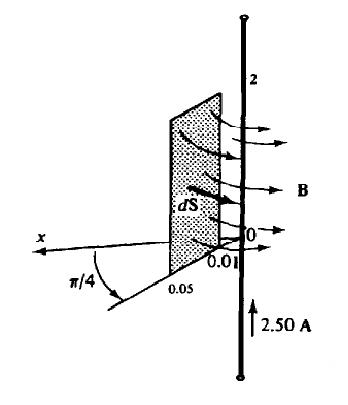
Figure 2.5 Example Problem 4
B = μ0 H = (μ0 I/2πr) aϕ
dS = dr dz aϕ
Φ = ∫02∫0,010,05(μ0I/2πr) aϕ dr dz aϕ
=(2μ0I/2π) ln0,05/0,01
=1,61×10(-6) Wb
=1,61 μWb
It should be noted that the magnetic flux lines Φ are closed curves (curves), which have no starting and ending points. This differs from the electric flux ψ which originates from a positive charge and ends up being negatively charged. As shown in Figure 2.5, all flux lines Φ that enter a closed surface will come out again from that surface. Therefore, field B has neither a source nor a hole, which is mathematically expressed by the following equation.
∇.B=0
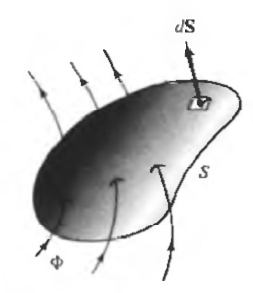
Figure 2.6 Flux Lines Entering a Closed Surface
2.6 Magnetic Vector Potential A
Initially, the electric field E is obtained from a known charge configuration. Later developed an understanding of the electric potential V, where E we see can be obtained as negative from the gradient, namely E = -∇V. Laplace's equation then provides a means of obtaining V from the knowledge of the potential magnitude at the conductive boundaries. Similarly, the magnetic vector potential A is defined such that,
∇ X A = B
serves as an intermediate quantity, from which B and H. can be calculated. Note that the definition of A is consistent with the terms ∇. B = 0. The unit of A is Wь / m or Hm. If additional conditions are applied, then:
∇∙A=0
Then the potential vector A can be determined from the known currents in the area under study. For the three types of standard current configurations, the equations are as follows:
Filament Current: A = ∮(μIdI/4πR)
surface current: A = ∫S(μKdS/4πR)
volume flow: A = ∫v(μJdv/4πR)
Here R is the distance of the current element at the point where A is to be calculated. As with similar integrals for electric potential, the equations for A above are based on the assumption of a zero price level at infinity; therefore, the previous formulas cannot be used if the currents themselves continue to infinity.
Sample Problem 5:
Check the magnetic potential vector for a long straight line I of current, in free space.
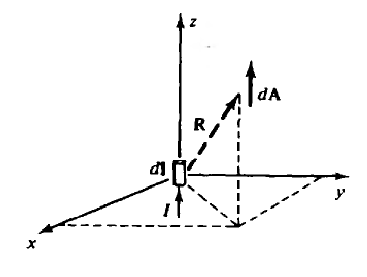
Figure 2.7 Example Problem 5
In Figure 2.7 the current is along the z-axis and the field points are (x, y, z). Also shown is a current element
I dI=Idl az
At l = 0, where l is the variable that changes along the z-axis. It is clear that integral,
A = ∫(-∞)∞(μ0 I dl/4πR) az
However, it is possible to consider a differential potential vector.
dA = (μ0 I dl/4πR) az
And obtain from it the differential B. Thus, by the special current element at l = 0, we have
dA=(μ0 I dl)/(4π(x2+y2+z2)(1⁄2) ) ax
dB=∇×dA
=(μ0 I dl/4π) [(-y)/(x2+y2+z2)(3⁄2) ax+x/(x2+y2+z2)(3⁄2) ay ]
This result corresponds to the dH = (I⁄μ0)dB given by the Biot-Savart law
2.7 Stokes' theorem
On an open surface S bounded by a closed curve C. Stokes' theorem says that the tangential component integral of the vector field F along C is the same as the normal component integral of the curl F through the surface S:
∮F.dl = ∫s(∇×F).dS
If F is chosen to be the magnetic potential vector A, then Stokes' Theorem can be formulated as follows:
∮A.dl = ∫sB.dS = Φ
Chapter 3 Closing
3.1 Conclusion
The conclusions that can be drawn from this paper are as follows:
- Differential magnetic field, dH is the result of the current element differential I dH. Where, the field is inversely proportional to distance (r2), and is and has a direction which is the cross product of I dI and aR. This relationship is known as Biot-Savart's Law, where the equation can be seen as: dH = (I dI x aR)/(4πR2) (A/m)
- The line integral of the tangential component H along the closed path is equal to the magnitude of the current around the path, ∮H.dI = I enc
- To take advantage of Ampere's law to determine H there must be a sufficiently high degree of symmetry to the problem at hand. Two conditions that must be met are as follows: H must be normal or tangential at each point of its path. H has the same or fixed value for each point of its path, if H is tangential.
- The curl of the vector field A is another vector field. The curl component of A in the direction an can be defined as follows: (curl A).an = lim(∆S → 0) (∮A.dI)/∆S
- The relationship between J and H, is one of Maxwell's equations in the static electric field. if H is known for the entire region, then ∇ × H = J will give J for the region.
- The magnetic field strength H depends only on the (moving) charges and does not depend on the medium. The force field corresponding to H is the magnetic flux density B in Tesla units, and can be formulated as: B = μH
- The potential vector A can be determined from the known currents in the area under study. For the three types of standard current configurations, the equations are as follows: Filament current: A = ∮ (μI dI) / 4πR Surface current: A = ∫S (μK dS) / 4πR Volume flow: A = ∫v (μJdv) / 4πR
- In Stokes' Theorem if the tangential component integral of the vector field F along C is equal to the integral of the normal component of curl F through the surface S, then it is formulated as: denganF.dl = ∫s (∇ × F).dS However, if F selected to be the magnetic potential vector A, then the Stokes Theorem can be formulated as follows: ∮A.dl = ∫sB.dS = Φ
3.2 Suggestion
After the authors made this assignment, the suggestions that can be suggested are in performing calculations using the above formulas, one should properly master the concepts in their use, so that there are no fundamental errors in the process.
Bibliography
- Edminister, Joseph A. 1993. Schaum’s Outline Of Theory and Problems or Electromagnetics 2nd Edition. United States of America : The McGraw-Hill
- Hayt, William H. 1982. Elektromagnetika Teknologi Jilid 2. Jakarta Pusat : Erlangga
Tugas Kuliah Hukum Ampere dan Medan Magnetik
Catatan
Ini merupakan tugas S1 saya di mata kuliah Teori Medan Listrik dimana tugasnya adalah menulis essai mengenai hukum ampere dan medan magnetik. Selain saya kelompok ini terdiri dari Vencisisca Jeane R, Rr. Sanita Eling Cipta Nesa, Putu Arie Pratama, Fajar Purnama, Muhammad Audy Bazly, Muhamad Nordiansyah. Tugas ini tidak pernah dipublikasi dimanapun dan kami sebagai penulis dan pemegang hak cipta melisensi tugas ini customized CC-BY-SA dimana siapa saja boleh membagi, menyalin, mempublikasi ulang, dan menjualnya dengan syarat mencatumkan nama kami sebagai penulis dan memberitahu bahwa versi asli dan terbuka tersedia disini.
BAB 1 Pendahuluan
1.1 Latar Belakang
Dalam kehidupan sehari-hari banyak penerapan dari beberapa hukum-hukum fisika yang terjadi, salah satunya yaitu hukum ampere dan medan magnetik. Dimana secara umum hubungan antara hukum ampere dan medan magnetik, yaitu hukum ampere menyatakan bahwa medan magnet dapat ditimbulkan melalui dua cara yaitu lewat arus listrik (perumusan awal hukum ampere), dan dengan mengubah medan listrik (tambahan Maxwell). Koreksi Maxwell terhadap hukum ampere cukup penting, dengan demikian hukum ini menyatakan bahwa perubahan medan listrik dapat menimbulkan medan magnet, dan sebaliknya.
Tiga orang ilmuwan jenius dari perancis, Andre Marie Ampere (1775-1863), Jean Baptista Biot (1774-1862) dan Victor Savart (1803-1862) menyatakan bahwa gaya akan dihasilkan oleh arus listrik yang mengalir pada suatu penghantar yang berada diantara medan magnetik. Hal ini juga merupakan kebalikan dari hukum Faraday, dimana Faraday memprediksikan bahwa tegangan induksi akan timbul pada penghantar yang bergerak dan memotong medan magnetik. Hukum ini diaplikasikan pada mesin-mesin listrik, dan gambar dibawah ini akan menjelaskan mengenai fenomena tersebut.
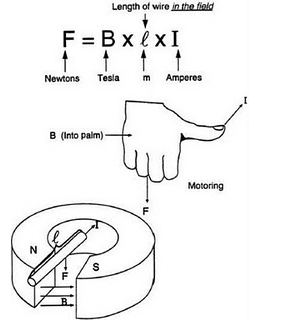
Gambar 1.1 Kaedah Tangan Kanan
1.2 Rumusan Masalah
Adapun permasalahan yang diangkat dalam makalah ini adalah sebagai berikut:
- Apakah yang dimaksud dengan hukum ampere dan medan magnetik ?
- Bagaimanakah hubungan antara kerapatan arus dengan medan magnetik ?
- Apakah yang dimaksud dengan kerapatan fluks magnetik ?
- Apakah yang dimaksud dengan potensial vektor magnetik dan bagaimanakah penerapannya ?
- Apakah yang dimaksud dengan teorema stokes ?
1.3 Tujuan
Tujuan utama dari penulisan makalah “ Hukum Ampere dan Medan Magnetik “ kali ini adalah untuk mengetahui dan memahami secara rinci mengenai hukum ampere dan medan magnetik. Adapun tujuan lain dari pembuatan makalah ini adalah:
- Mampu mendefinisikan serta menjelaskan mengenai hukum amper dan medan magnetik.
- Mengetahui bagaimana hubungan antara kerapatan arus dengan medan magnetik.
- Mampu mendefinisikan serta mengetahui mengenai kerapatan fluks magnetik.
- Mampu menjelaskan mengenai pengertian dari potensial vektor serta mampu menjelaskan bagaimanakan penerapannya.
- Mampu mendefinisikan mengenai teorema stikes.
1.4 Manfaat
Manfaat yang diperoleh dari makalah “ Hukum Ampere dan Medan Magnetik “ ini adalah sebagai berikut:
- Memberikan pengetahuan mengenai hukum ampere dan medan magnetik secara mendalam.
- Memberikan pengetahuan mengenai hubungan antara arus ataupun kerapatan arus dengan medan magnetik.
- Memberi pengetahuan mengenai potensial vektor yang dapat ditentukan dari arus.
1.5 Ruang Lingkup Materi
Dalam makalah ini, ruang lingkup yang dibahas oleh penulis hanya sebatas mengenai permasalahan yang di bahas, yaitu sebatas Hukum Ampere dan Medan Magnetik.
BAB 2 Pembahasan
2.1 Hukum Biot-Savart
Differensial medan magnetik, dH merupakan hasil dari differensial elemen arus I dH. Medan berbanding terbalik dengan jarak (r2), merupakan media bebas yang ada sekitarnya dan memiliki arah yang merupakan cross product dari I dI dan aR .Hubungan ini diketahui sebagai Hukum Biot-Savart, dimana dapat persamaan tersebut, dilihat seperi dibawah ini :
dH = (I dI x aR)/(4πR2) (A/m)
Arah dari R harus berasal dari elemen arus pada titik dimana dH sudah ditentukan, seperti pada gambar berikut:

Gambar 2.1 Arah R dan dH
Elemen arus tidak boleh dipisahkan. Semua elemen melengkapi kontribusi filament arus ke H dan arus harus terlibat. Bentuk integral dalam Hukum Biot-Savart adalah sebagai berikut:
H = ∮(I dI x aR)/(4πR2)
Integral tertutup sederhana membutuhkan semua elemen arus yang dilibatkan dalam memperoleh nilai H.
Contoh Soal 1:
Arus I yang panjang dan lurus sepanjang sumbu z dari koordinat silindris adalah seperti tampak pada gambar dibawah ini.

Gambar 2.2 Contoh Soal 1
Tanpa kehilangan sesuatu sifat umumnya, pilih suatu titik dalam bidang z = 0. Maka dalam bentuk differensialnya, adalah sebagai berikut:
dH = (I dz ax X (rar X zaz) / (4π(r2+z2)<sup>(3⁄2))
= (I dz ra∅) / (4π(r2+z2)(3⁄2))
H = [∫-∞∞(Ir dz) / (4π(r2+z2)(3⁄2))] a∅
= a∅/2πr
Medan magnetik oleh arus permukaan dan volume juga diberikan oleh hukum Biot-Savart bentuk integral, dengan I dI digantikan oleh K dS atau Jdv masing-masingnya, dan dimana integral itu diambil diseluruh permukaan, atau volume, yang bersangkutan. Contoh penting adalah arus pada bidang datar tak berhingga dengan kerapatan K yang konstan. Dimana persamaannya dapat dilihat sebagai berikut ini:
H = K/2 X an
2.2 Hukum Ampere
Integral garis dari komponen tangensial H sepanjang lintasan tertutup adalah sama dengan besarnya arus yang berada di sekitar lintasan itu:
∮H.dI = Ienc
Ini merupakan hukum Ampere. Pada pengamatan pertama, kita barangkali akan mengira bahwa penerapan hukum ini adalah untuk menentukan arus dengan suatu integrasi. Padahal, biasanya arusnya telah dikenal dan hukum ini akan memberi kita cara menentukan H. Jadi penerapan hukum tadi sangat serupa dengan penggunaan hukum Gauss untuk menentukan D dalam distribusi muatan yang diberikan.
Untuk dapat memanfaatkan hukum Ampere dalam menentukan H haruslah ada simetri bertaraf cukup tinggi pada masalah yang dibahas. Dua syarat yang harus dipenuhi, adalah sebagai berikut:
- H haruslah bersifat normal atau tangensial pada setiap titik lintasannya.
- H memiliki nilai yang sama atau tetap untuk setiap titik lintasannya, jika H bernilai tangensial.
Hukum Biot-Savart dapat digunakan untuk menentukan dalam memilih lintasan yang memenuhi syarat-syarat itu. Tapi dalam banyak hal, lintasan tersebut akan segera terlihat.
Contoh Soal 2:
Gunakan hukum ampere untuk memperoleh H oleh arus I yang panjang dan lurus. Hukum Biot-Savart menunjukkan H adalah tangensial dan dengan besar yang sama sepanjang lingkaran pada gambar 2.3, Maka persamaannya adalah sebagai berikut:
∮H.dI=H(2πr)=I
H = aϕ/2πr
2.3 Curl
Curl dari medan vektor A merupakan medan vektor yang lain. Titik P pada gambar 2.3 terletak di area ∆S yang dibatasi oleh kuva tertutup C.

Gambar 2.3 Curl pada Titik A
Dalam integrasi yang mendefinisikan curl, C merupakan area yang dilalui oleh curl sehingga area yang tertutup berada disebelah kiri. Unit normal an , ditentukan dengan menggunakan aturan kaedah tangan kanan, seperti yang ditunjukkan pada gambar. Maka, komponen curl dari A dalam arah an akan didefinisikan sebagai berikut:
(curl A).an = lim(∆S→0)(∮A.dI/∆S)
Dalam sistem koordinat, curl A merupakan nilai spesifikasi sepenuhnya yang ditentukan oleh komponen di sepanjang tiga unit vektor tersebut. Sebagai contoh, komponen x pada koordinat kartesian didefinisikan dengan cara mengambil garis kontur C persegi pada bidang x = conts, melalui titik P, seperti yang ditunjukkan pada gambar 2.5:
(curl A).an = lim(∆y ∆z→0) (∮A.dI / ∆y ∆z)

Gambar 2.4 Curl pada Bidang Persegi
Jika, A = Axax + Ayay + Azaz , pada sudut dari ∆S tertutup ke titik pusat (titik 1), kemudian:
∮ = ∫12 + ∫23 + ∫34 + ∫41
=Ay∆y + (Az+(∂Az/∂y∆y))∆z + (Ay+(∂Ay/∂z∆z))(-∆y) + Az(-∆z)
=((∂Az/∂y)-(∂Ay/∂z)) ∆y∆z
(curl A).ax = (∂Az/∂y)-(∂Az/∂z)
Untuk komponen y dan z dapat ditentukan dengan cara yang sama. Kombinasi ketiga komponen, dapat dilihat pada persamaan di bawah ini:
curl A = ((∂Az/∂y)-(∂Az/∂z)) ax+((∂Ax)/∂z-(∂Az)/∂x) ay+((∂Ay)/∂x-(∂Ax)/∂x) az (cartesian)
Penentu urutan ketiga dapat ditulis seperti persamaan di bawah ini, ekspansi yang memberikan curl Cartesian dari A.
curl A=|(ax&ay&az @ ∂/∂x&∂/∂y&∂/∂z @ Ax&Ay&Az)|
Elemen dari baris kedua merupakan komponen dari operasi del. Ini menunjukkan bahwa ∇×A dapat ditulis untuk curl A. Seperti pada ekspresi lain dari suatu analisis vektor, notasi ini digunakan untuk curl A dalam sistem koordinat lain, meskipun∇×A hanya didefinisikan dalam koordinat Cartesian saja.
Ekspresi untuk curl A pada koordinat silinder dan bola dapat diturunkan dengan cara yang sama seperti di atas. Meskipun, dengan kesulitan yang lebih tinggi.
curl A = (1/r (∂Az)/(∂∅) - (∂A∅/∂z)) ar + ((∂Ar/∂z) - (∂Az/∂r)) a∅ + ((∂(rA∅))/∂r - (∂Ar/∂∅)) az (silinder)
curl A = 1/(r sin ) [(∂(A∅ sinθ))/∂θ - (∂θ/∂∅)] ar+1/r [1/sinθ (∂Ar/∂∅)-(∂(rA∅)/∂r)] a∅ + 1/r [(∂(rA∅))/∂r-(∂Ar)/(∂∅)] az (sperikal)
Frekuensi penggunaan dari dua sifat operator curl, dapat dijelaskan sebagai berikut:
- Perbedaan dari curl adalah nol skalar, yaitu: ∇.(∇×A) = 0 untuk setiap medan vektor A
- Curl dari gradien adalah nol vektor, yaitu: ∇.(∇f) = 0 untuk setiap fungsi skalar dari f posisi (lihat problem) Dalam kondisi statis, E=-∇V, sehingga ∇×E=0
2.4 Hubungan dari J dan H
Pada hukum ampere, definisi persamaan dari (curl H)x dapat ditulis sebagai berikut:
(curl H).ax=lim(∆y ∆z→0)Ix/(∆y ∆z)- Jx
Dimana Jx=dlx⁄dS merupakan daerah kerapatan dari x arah arus. Sehingga komponen x dari curl H dan arah arus J sama pada setiap titik. Demikian pula pada komponen x dan y, dapat dilihat sebagai berikut.
∇×H=J
Ini merupakan salah satu persamaan dari Maxwell yang terdapat pada medan listrik statis. jika H diketahui pada seluruh daerah, maka ∇×H=J akan menghasilkan J untuk daerah tersebut.
Contoh Soal 3:
Sebuah konduktor yang panjang penampangnya lurus dengan jari-jari a memiliki kekuatan medan magnet H = (Ir⁄(2πa2)) didalam konduktor (r <a) dan="" h="(I⁄2πr)a∅" untuk="" r="">a. Tentukan J dikedua daerah konduktor tersebut ! Didalam kondustor,</a)>
J = ∇×H = -∂/∂z (Ir/(2πa2 )) ar+1/r ∂/∂r ((Ir2)/(2πa2 )) az = I/(πa2)az
yang sesuai dengan arus besarnya I pada arah + z yang terdistribusi merata diatas daerah penampang πa2. Diluar konduktor,
J = ∇×H = -∂/∂z (I/2πr) ar+1/r ∂/∂r (I/2π) az = 0
2.5 Kerapatan Fluks Magnetik B
Seperti D, kuat medan magnetik H bergantung hanya pada muatan-muatan (yang bergerak) dan tak bergantung pada mediumnya. Medan gaya yang berkaitan dengan H adalah kerapatan fluks magnetik B, yang diberikan oleh:
B = μH
Dimana = μo μr , adalah permeabilitas medium tersebut dan satuan dari B adalah tesla.
1 T = 1 N/(A .m)
Permeabilitas ruang hampa μ0 mempunyai nilai 4π×10(-7)dan satuan henry per meter H⁄m, permeabilitas relatif μr medium adalah suatu bilangan murni yang sangat dekat dengan satu.
Fluks magnetik Φ, yang melalui suatu permukaan didefiniskan sebagai berikut.
Φ = ∫SB .dS
Tanda Φ dapat positif atau negatif bergantung pada pilihan arah normal pada dS dan satuan fluks tersebut adalah weber, Wb. Satuan magnetik yang berbeda-beda ini dihubungkan melalui persamaan berikut.
1 T = 1 Wb⁄m2 1 H = 1 Wb⁄A
Contoh Soal 4:
Tetapkan besarnya fluks yang melalui bagian bidang ϕ = π⁄4 yang ditentukan oleh 0,01 < r < 0,05 m dan 0 < z < 2 m. Suatu arus sebesar 2,50 A sepanjang sumbu z adalah searah dengan az.

Gambar 2.5 Contoh Soal 4
B = μ0 H = (μ0 I/2πr) aϕ
dS = dr dz aϕ
Φ = ∫02∫0,010,05(μ0I/2πr) aϕ dr dz aϕ
=(2μ0I/2π) ln0,05/0,01
=1,61×10(-6) Wb
=1,61 μWb
Perlu diperhatikan bahwa garis-garis fluks magnetik Φ merupakan kurva (lengkungan) tertutup, yang tak mempunyai titik awal dan titik akhir. Ini berbeda dengan fluks listrik ψ yang berpangkal dimuatan positif dan berakhir dimuatan negatif. Seperti tampak pada gambar 2.7, semua garis fluks Φ yang masuk suatu permukaan tertutup, akan keluar lagi dari permukaan itu. Oleh karena itu, medan B tak mempunyai sumber ataupun lubang, yang secara matematis dinyatakan dengan persamaan berikut.
∇.B=0

Gambar 2.6 Garis Fluks yang Masuk pada Permukaan Tertutup
2.6 Potensial Vektor Magnetik A
Pada mulanya medan listrik E diperoleh dari konfigurasi muatan-muatan yang telah diketahui. Belakangan dikembangkan pengertian potensial listrik V dimana E kita lihat dapat diperoleh sebagai negatif dari gradiennya, yakni E=-∇V. Persamaan Laplace kemudian memberikan cara memperoleh V dari pengetahuan besarnya potensial di perbatasan penghantar-penghantar. Demikian pula, potensial vektor magnetik A yang didefinisikan sedemikian sehingga,
∇ X A = B
berfungsi sebagai besaran perantara, dari mana dapat dihitung B dan H. Perhatikan bahwa definisi A konsisten dengan syarat ∇ . B=0. Satuan A adalah Wь/m atau T • m . Kalau diterapkan syarat tambahan, maka:
∇∙A=0
Maka potensial vektor A dapat ditentukan dari arus-arus yang diketahui di dalam daerah yang ditinjau. Untuk ketiga macam konfigurasi arus yang baku, persamaan - persamaannya adalah sebagai berikut:
Arus filamen : A = ∮(μIdI/4πR)
arus permukaan : A=∫S(μKdS/4πR)
arus volume : A=∫v(μJdv/4πR)
Di sini R adalah jarak elemen arus di titik dimana A hendak dihitung. Sebagaimana pula pada integral serupa bagi potensial listrik, persamaan-persamaan untuk A di atas adalah berdasarkan penganggapan tingkat harga nol di kedudukan tak berhingga; sebab itu rumus-rumus tadi tak dapat dipakai apabila arus-arus itu sendiri berlanjut sampai tak berhingga.
Contoh Soal 5:
Periksalah vektor potensial magnetik untuk arus garis I yang panjang dan lurus, dalam ruang bebas.

Gambar 2.7 Contoh Soal 5
Dalam gambar 2.8 arus itu sepanjang sumbu z dan titik medan adalah (x,y,z). Ditunjukkan pula suatu elemen arus
I dI=Idl az
Pada l = 0 , dimaana l adalah variabel yang berubah sepanjang sumbu z. Jelaslah kiranya bahwa integral,
A = ∫(-∞)∞(μ0 I dl/4πR) az
Akan tetapi, mungkin saja kita meninjau potensial vector diferensial.
dA = (μ0 I dl/4πR) az
Dan memperoleh dari padanya diferensial B. Jadi, oleh elemen arus yang khusus di l = 0, kita peroleh
dA=(μ0 I dl)/(4π(x2+y2+z2)(1⁄2) ) ax
dB=∇×dA
=(μ0 I dl/4π) [(-y)/(x2+y2+z2)(3⁄2) ax+x/(x2+y2+z2)(3⁄2) ay ]
Hasil ini sesuai dengan dH=(I⁄(μ0)dB) yang diberikan oleh hukum Biot-Savart
2.7 Theorema Stokes
Pada suatu permukaan terbuka S yang dibatasi oleh kurva tertutup C. Teorema Stokes mengatakan bahwa integral komponen tangensial medan vektor F sepanjang C adalah sama dengan integral komponen normal dari curl F melalui permukaan S:
∮F.dl = ∫s(∇×F).dS
Jika F dipilih menjadi potensial vector magnetik A, maka Teorema Stokes dapat dirumuskan sebagai berikut:
∮A.dl = ∫sB.dS = Φ
BAB 3 Penutup
3.1 Kesimpulan
Adapun kesimpulan yang dapat ditarik dari makalah ini, adalah sebagai berikut:
- Differensial medan magnetik, dH merupakan hasil dari differensial elemen arus I dH. Dimana, medan berbanding terbalik dengan jarak (r2), dan merupakan dan memiliki arah yang merupakan cross product dari I dI dan aR. Hubungan ini diketahui sebagai Hukum Biot-Savart, dimana dapat persamaan tersebut, dilihat seperi dibawah ini : dH = (I dI x aR)/(4πR2 ) (A/m)
- Integral garis dari komponen tangensial H sepanjang lintasan tertutup adalah sama dengan besarnya arus yang berada di sekitar lintasan itu, ∮H .dI=Ienc
- Untuk memanfaatkan hukum Ampere dalam menentukan H haruslah ada simetri bertaraf cukup tinggi pada masalah yang dibahas. Dua syarat yang harus dipenuhi, adalah sebagai berikut : H haruslah bersifat normal atau tangensial pada setiap titik lintasannya. H memiliki nilai yang sama atau tetap untuk setiap titik lintasannya, jika H bernilai tangensial.
- Curl dari medan vektor A merupakan medan vektor yang lain. Komponen curl dari A dalam arah an dapat didefinisikan sebagai berikut : (curl A).an=lim(∆S→0)(∮A .dI)/∆S
- Hubungan antara J dan H, merupakan salah satu persamaan dari Maxwell yang terdapat pada medan listrik statis. jika H diketahui pada seluruh daerah, maka ∇×H=J akan menghasilkan J untuk daerah tersebut.
- Kuat medan magnetik H hanya bergantung pada muatan-muatan (yang bergerak) dan tak bergantung pada mediumnya. Medan gaya yang berkaitan dengan H adalah kerapatan fluks magnetik B dengan satuan Tesla, dan dapat dirumuskan dengan : B=μH
- Potensial vektor A dapat ditentukan dari arus-arus yang diketahui di dalam daerah yang ditinjau. Untuk ketiga macam konfigurasi arus yang baku, persamaan - persamaannya adalah sebagai berikut : Arus filamen : A=∮(μI dI)/4πR Arus permukaan : A=∫S(μK dS)/4πR Arus volume : A=∫v(μJ dv)/4πR
- Dalam Teorema Stokes jika integral komponen tangensial medan vektor F sepanjang C adalah sama dengan integral komponen normal dari curl F melalui permukaan S, maka dirumuskan dengan : ∮F.dl= ∫s(∇×F).dS Namun, jika F dipilih menjadi potensial vector magnetik A, maka Teorema Stokes dapat dirumuskan sebagai berikut : ∮A.dl= ∫sB .dS= Φ
3.2 Usul dan Saran
Setelah penulis membuat makalah ini, maka usul dan saran yang dapat penulis sarankan adalah dalam melakukan perhitungan dengan menggunakan rumus-rumus diatas, hendaknya menguasai secara benar konsep-konsep dalam penggunaannya, agar tidak terjadi kesalahan yang mendasar dalam pengerjaannya.
Daftar Pustaka
- Edminister, Joseph A. 1993. Schaum’s Outline Of Theory and Problems or Electromagnetics 2nd Edition. United States of America : The McGraw-Hill
- Hayt, William H. 1982. Elektromagnetika Teknologi Jilid 2. Jakarta Pusat : Erlangga
Mirror
- https://www.publish0x.com/fajar-purnama-academics/ampere-law-and-magnetic-fields-class-assignment-xmkpqdx?a=4oeEw0Yb0B&tid=hive
- https://0fajarpurnama0.github.io/bachelor/2020/10/05/ampere-law-and-magnetic-field-assignment
- https://0fajarpurnama0.medium.com/ampere-law-and-magnetic-fields-class-assignment-3b01315b6651
- https://hicc.cs.kumamoto-u.ac.jp/~fajar/bachelor/ampere-law-and-magnetic-field-assignment
- https://0darkking0.blogspot.com/2020/12/ampere-law-and-magnetic-fields-class.html
- https://0fajarpurnama0.cloudaccess.host/index.php/9-fajar-purnama-academics/136-ampere-law-and-magnetic-fields-class-assignment
- http://0fajarpurnama0.weebly.com/blog/ampere-law-and-magnetic-fields-class-assignment
- https://0fajarpurnama0.wixsite.com/0fajarpurnama0/post/ampere-law-and-magnetic-fields-class-assignment
- https://read.cash/@FajarPurnama/ampere-law-and-magnetic-fields-class-assignment-3a5783f8
- https://www.uptrennd.com/post-detail/ampere-law-and-magnetic-fields-class-assignment~ODI3OTcw